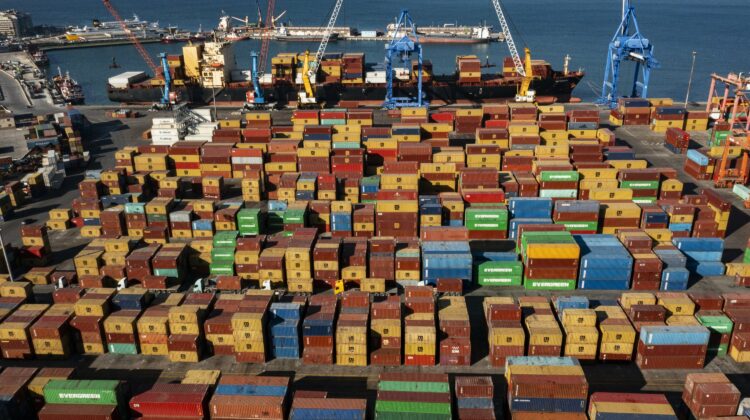
The Future of India’s Merchandise Exports is moving beyond service reliance
NEW DELHI : Merchandise exports grew only 1.02 per cent from $211.08 billion to $213.22 billion. Services exports did exceedingly well, rising 9.66 per cent from $164.14 billion to $180 billion.
The World Trade Organization (WTO) released the world trade outlook earlier this month, projecting 2.7 per cent growth of merchandise trade during 2024. In January-June 2024, the WTO reported Indian merchandise export growth at 4 per cent, against our merchandise export growth of only about 1 per cent during April-September, as per our data.
Is India’s merchandise growth slipping? Will services keep bailing out exports?
China is our bugbear
Exports to China, our fourth largest export market in the first half of 2023-2024 with India exporting $7.63 billion of goods, recorded a degrowth of 9.35 per cent, downgrading China to fifth place, with exports declining to $6.91 billion.
Our largest export market, the United States, recorded a healthy growth of 5.6 per cent with the first half of 2023-2024 exports growing from $38.23 billion to $40.38 billion. Our next three largest export markets — the United Arab Emirates, the Netherlands, and the United Kingdom — also did very well, recording an impressive growth of 11.45 per cent, 36.73 per cent, and 12.40 per cent respectively.
Our inability to step up exports to China continues to stymie India’s overall export growth.
On the contrary, our import dependence on China has been growing unstoppably. India imported $56.29 billion worth of merchandise from China in the first half of 2024-2025, making 16 per cent of our total imports of $350.66 billion. Worryingly, imports from China recorded a growth of 11.52 per cent, much higher than overall import growth of 6.16 per cent.
This hurts. India’s merchandise trade deficit of $49.38 billion with China during April-September 2024 constituted 41 per cent of the total trade deficit of $119.24 billion.
Unable to capitalise on China+1 policy
Our principal export markets (the US and the European Union) desperately want to reduce dependence on Chinese imports and shift their imports to friendly countries like India. Policies of China+1 and the recent high import tariffs on Chinese electric vehicles (EVs) seek to achieve this objective.
India, unfortunately, has not been able to take advantage of these policies.
There have indeed been a few success stories like Apple contractors establishing a major production base in India resulting in India’s electronics exports growing handsomely ($15.64 billion in the first half of 2024-2025 against $13.06 billion in 2023-2024) recording growth of 19.74 per cent. There is, however, no widespread shift of manufacturing to India from China.
WTO data for January-June 2024 informs that against India’s merchandise export growth of 4 per cent, Vietnam recorded export growth of 16 per cent, Hong Kong, China 14 per cent, Chinese Taipei 11 per cent, Republic of Korea 10 per cent, and Singapore 6 per cent. China’s export growth of 4 per cent equalled India’s.
Services exports are bailing us out
India’s services exports at $204.76 billion in 2018-2019 made up 38.28 per cent of total exports of $534.84 billion. In 2023-2024, services exports of $341.25 billion rose to 43.93 per cent of the total exports of $776.89 billion.
In five years, services exports generated a decent CAGR of 10.76 per cent, gaining an additional 1 per cent share every year. In the first half of 2024-2025, the share of services exports rose further to 45.78 per cent. This trend is likely to continue.
Services exports would, most likely, exceed merchandise exports in 2029-2030 when Modi 3.0’s term comes to an end.
Services exports (IT services, GCCs, other commercial services and the likes) have been India’s saviour; but may not bail India out forever. It is time we capitalise on the promise of other services (sports, travel, entertainment, and personal services like education, health and personal care) besides strengthening other under-developed non-personal services (financial, software as service, and the likes).
Revamp export promotion framework
The government runs hundreds of schemes and spends billions of dollars promoting merchandise exports. Data tells you that it is unfortunately making no real difference.
Services exports, on the other hand, have been growing handsomely despite no promotional and financial support from the government. Let the government shift 25 per cent of the resources it spends on merchandise export promotion and invest it in building infrastructure for promoting services export and in providing services tax support.
It might sound ironic, but it is a fact. Dependence on Chinese imports can be best reduced/eliminated by getting Chinese companies to make the products which India imports from China (solar cells and modules, electronic goods, pharmaceutical APIs etc.) in India. Such a strategic shift will also give India a much better ‘control’ if Chinese companies were to invest in setting up manufacturing plants in India. We need to review our restrictive policies of discouraging Chinese investment.
US companies need to be offered a business case to invest in India to marry India’s talent and US technology. A good beginning has been made in semiconductors. Let many more flowers bloom.
The combination of high-technology product manufacturing investments from both China and the US and a very businesslike services promotion policy can turn India into an export powerhouse.
